Metal Braces
Metal braces are the most common type of braces for orthodontic patients. Today’s metal braces are much smaller, flatter, and more comfortable than in the past. Patients of all ages choose metal braces to help them achieve straight, beautiful smiles.
What Braces Are Made of
Traditional metal braces are made of high-quality stainless steel or titanium. The three main parts of your braces are:
- Brackets — Brackets are attached to the teeth using special glue that bonds them to the tooth surface and holds them in place.
- Archwire — The archwire is the thin metal wire that connects each bracket and puts pressure on the teeth to help guide them into place.
- Ligature Elastic (also known as the “rubber bands”) — Elastics, or rubber bands, are the colored ties that hold the archwires to the brackets. Dr. Thangamani will change the elastics at each appointment. Elastics may come in a variety of colors.
How Braces Work
Once placed on your teeth, braces exert constant pressure on your teeth, and the force of the pressure helps move them into proper position. At each appointment, Dr. Thangamani may tighten the archwires. In addition to braces, some patients may need to wear rubber bands or headgear. Patients who wear braces may notice their teeth feeling a little loose. This is normal and temporary; once the teeth are done moving, this feeling will go away.
Metal Braces for All Ages
Traditional metal braces are still the most popular, quickest, and most cost-effective orthodontic treatment available. We can help you determine what treatment is best for your individual case. Please contact our practice to schedule an appointment and learn more about how braces can enhance your smile.
Having braces doesn’t necessarily require highly noticeable metal brackets and wires. In fact, many of today’s braces are made from either clear or natural tooth-colored materials to provide patients with an attractive, less noticeable alternative to traditional braces.
Clear Braces
What is the difference between clear braces and clear aligners?
Clear braces are the same as traditional metal braces, except that they are clear! Clear braces are a less noticeable alternative to traditional metal braces and provide patients with an equally effective treatment.
 Clear aligners are different from clear braces. Clear aligners are pieces of hard plastic designed to fit into your mouth like a mouthguard. Clear aligners are great for patients who require minor orthodontic treatment.
Clear aligners are different from clear braces. Clear aligners are pieces of hard plastic designed to fit into your mouth like a mouthguard. Clear aligners are great for patients who require minor orthodontic treatment.
What are the advantages and disadvantages to clear braces?
As with any orthodontic treatment, it is important to choose the right option for your needs and lifestyle. Clear braces are a great alternative to traditional metal braces and Dr. Thangamani will help you determine whether they are the right treatment for you.
Advantages to clear braces
- 1. Appearance: Ceramic braces and clear braces are much less noticeable than traditional metal braces. Clear and ceramic braces offer an aesthetic alternative for patients who seek options other than traditional metal braces.
- 2. Confidence: Many patients who choose ceramic or clear braces feel more confident about their orthodontic treatment, especially knowing that people are focusing on their smiles rather than their braces.
Disadvantages to clear braces
- 1. Cost: Ceramic and clear braces may cost more than traditional metal braces. Our office may offer convenient payment plans to help control the costs of your treatment. Be sure to talk to Dr. Carrie about all of your financial options.
- 2. Discoloration: The clear elastic ties used with clear and ceramic braces may become slightly discolored when you drink tea, coffee, or wine, and eat certain foods or smoke. Ask us about how you can keep your braces looking their best.
- 3. Treatment Time: Orthodontic treatment with clear or ceramic braces may take longer than with traditional metal braces. If you don’t mind investing a little more time in your smile, then talk to Dr. Thangamani to find out how long your treatment time will be with clear or ceramic braces.
Are clear or ceramic braces the right choice for my smile and me?
By talking to Dr. Carrie and our treatment coordinator, you can decide if clear or ceramic braces are the right treatment for you. Our office can provide answers to your questions and extra information explaining the benefits of each treatment. If you would like to learn more about clear braces, ceramic braces, and all of the options available to you, please contact our practice and schedule an appointment today.
Common Treatments
Crowding of the teeth

Before
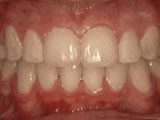
After
This boy started treatment at age 11 and wore braces for 26 months. He loves his new smile.
Open bite: front teeth don’t touch
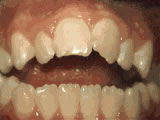
Before
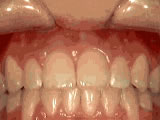
After
This girl sucked her thumb as a young child. She started treatment at age 13. She had braces and a special appliance — called a crib — to retrain the tongue, for 28 months. Now she can bite the lettuce out of a sandwich.
Deep overbite: lower front teeth bite into palate

Before

After
This adult patient, age 25, required braces and jaw surgery to correct his severe overbite. Treatment lasted two years. His problem could have been corrected without surgery if he had been treated before he was a teenager.
Missing lateral incisors

Before
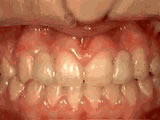
After
This patient’s lateral incisors were missing since birth. She had braces for 20 months to move the teeth into their correct positions, then the missing teeth were replaced with bonded “Maryland” bridges.
Underbite: lower front teeth in front of upper teeth
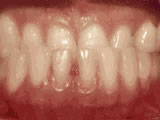
Before
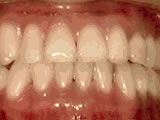
After
This woman’s underbite was causing her jaw joint discomfort and excessive wear patterns on her teeth. After about 30 months of treatment starting at age 32, she now finds smiling and chewing much easier.
Spacing of teeth
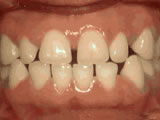
Before
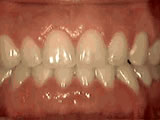
After
This patient was bothered by the spaces between his teeth. Braces closed the spaces and gave him an ideal bite in 24 months. Special glued-in retainers help keep the spaces closed.
Overjet: protruding front teeth
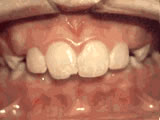
Before

After
At age ten, this girl had a big overjet, with the top teeth protruding beyond the bottom. She had two phases of treatment. The first helped her jaws to grow more harmoniously and the second aligned her teeth and bite. At age 13, she was proudly displaying her new smile.
Non-braces treatment
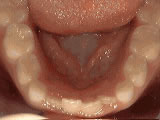
Before
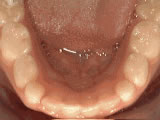
After
Sometimes braces are not needed to get noticeable improvements in tooth alignment. This patient was first seen at age seven for crowding of the lower permanent teeth. A procedure was performed to reduce the width of the adjacent baby teeth and the permanent incisors aligned on their own in nine months.
Phase-One

Before

After
This boy’s parents were concerned about both aesthetics and the health of the erupting permanent teeth when they brought him to the orthodontist at age eight. The lower front teeth were crowded and touching the palate, and the upper front teeth were extremely displaced from their normal positions. After 12 months of Phase-One treatment with an expander and partial braces, the patient’s appearance and dental function were vastly improved.

